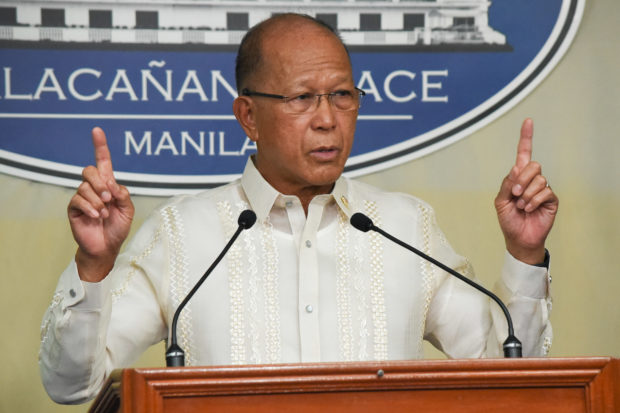
Defense Secretary Delfin Lorenzana provides updates on the operations against terrorists in Marawi City during a press briefing in Malacañang. PRESIDENTIAL PHOTO
Defense Secretary Delfin Lorenzana on Saturday said the government now believed the hundreds of gunmen who besieged Marawi City were being backed by the Islamic State (IS) because of the manner by which they fought.
Lorenzana told reporters in Marawi City that gunmen from the Maute Group and the Abu Sayyaf led by Isnilon Hapilon appeared determined to fight to the last man.
“Yes, we believe this is ISIS, because you know normally in this kind of conflict, the local armed groups will just scamper away and maybe hide in the mountains. But surprisingly, this group just held out there and were waiting to fire it out, maybe to the last [bullet],” he said, using another acronym for IS.
Lorenzana said the involvement of foreign fighters was another evidence of IS backing and that the government had obtained “some info” on the foreigners—two Saudi nationals, two Indonesians, two Malaysians, one Yemeni, one Indian and one Chechen. More foreign fighters could have been killed, he added.
He said the entry into Marawi of non-Asian foreign fighters was puzzling and he had asked officials how this might have happened. Malaysians and Indonesians look like Filipinos so it would not be surprising if they came in undetected, he said.
Lorenzana said the response he got was that the non-Asian fighters could have entered the city through the aid of some locals during the Tabligh, referring to a convention held by a group of Sunni Islamic missionaries in Marawi, which ended a day before the clashes began.
The Tabligh Jamaat is a global nonpolitical movement that aims to convince Muslims to return to the practice of primarily Sunni Islam.
Lorenzana said the IS was able to connect with the Maute Group through Hapilon, a Basilan-based leader of the Abu Sayyaf and reportedly the acknowledged leader of all IS-inspired groups in the country.
“Part of [the] instruction that Hapilon got from [IS] in Middle East is to come to Lanao and establish a wilayat or a province. That’s why he was elevated to the rank of emir by [IS],” he said.
Lorenzana said the government would “try to contain” Isnilon’s fighters in Marawi but could not say how much longer the fighting would go on.
He said 200 to 300 gunmen were contained in Barangay Banggolo, Marawi’s central business district surrounded by troops.
In Manila, presidential spokesperson Ernesto Abella said on state-run Radyo ng Bayan there was no information that the gunmen were continuing to receive assistance from the outside.
He said the gunmen had a “well-planned” siege and made “adequate preparations,” which explained why they did not seem to run out of provisions and ammunition.
Abella said the gunmen also collected ammunition and firearms during their raid on the city jail and from the armories they had ransacked. They also deliberately retreated to the commercial areas of the city where they could get provisions they needed.
“The enemy is turning out to be more well-entrenched than initially thought, which shows that putting Mindanao under martial law was a wise decision,” Abella said. —WITH REPORTS FROM ALLAN NAWAL AND LEILA B. SALAVERRIA